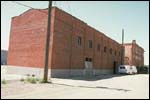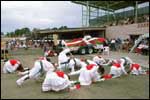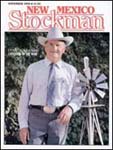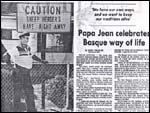 |
 |
 |
 |
 |
<< subjects
>> |
 |
 |
18.-
Utah, Arizona, New Mexico and Colorado
18.1
IN THE LAND OF THE MORMONS
The State of Utah has been witness to a significant Basque presence
since the late 19th century. Ogden, a city founded in 1890 to the
north of Salt Lake City, became a major railway junction, where
the line from the east branched off into two directions. Several
hotels went up, and there were the beginnings of a Basque community.
In 1914 a group of Basques who had settled in the city approved
the statutes and founded the Basque Club of Utah, a pioneer among
those established in the west.
|
 |
 |
|
18.2
UTAH-KO TRISKALARIAK
To the southeast of Ogden, the more modest town of Price was home
to a small Basque population and to ostatuak associated with sheepherding.
Other towns had ostatuak and a Basque population that worked more
in mining, among them Highland Boy and Park City. Since the early
20th century, Salt Lake City has also had several ostatuak. These
include the Hogar Hotel (1927), directed by John and Claudia Landa.
For years it was a meeting point for the local Basque community.
Salt Lake is today site of the Basque Club of Utah. Its dance group,
known as the Utah-ko Triskalariak, has several outings throughout
the year, mainly to the neighboring states of Nevada, Idaho, and
Wyoming.
|
 |
|
18.3
SECOND CLUB IN THE US
The Basque presence in Arizona, New Mexico, and Colorado came at
an early stage associated, as in much of the west, with sheep raising.
There were hotels in Flagstaff and Willows in Arizona, and Grants
in New Mexico. In the history of this part of the country we find
the explorer Juan de Oñate, who, in the service of the Spanish
Crown, in 1598 founded San Gabriel, the second city in the United
States. The city of Durango is in New Mexico, which takes its name
from the Mexican city of Durango, in turn founded in the mid-16th
century by Francisco de Ibarra of the original Durango, in Bizkaia.
|
 |
|
18.4
COLORADO AND JEAN URRUTY
In the 1920's and 1930's Colorado had at least three ostatuak in
Grand Junction, namely the Star, the Retolaza, and the Eisaguirre.
Also Jean Urruty of Lower Navarre, arrived in the United States
in 1928, opened a hotel while he was in the livestock business.
He was an outstanding individual that stood out in Basque life throughout
the west. He succeeded in making a fortune and sponsored outstanding
festivals and other Basque events. The Basque Club of Grand Junction
was set up around him. He built a pelota court, and he brought dance
groups that came from thousands of kilometers away to Grand Junction.
|
 |
|
|
 |
 |
 |
|
|




